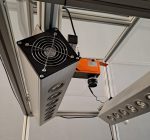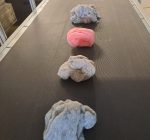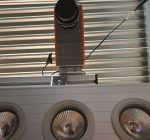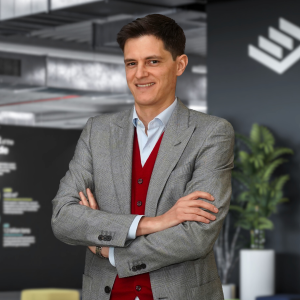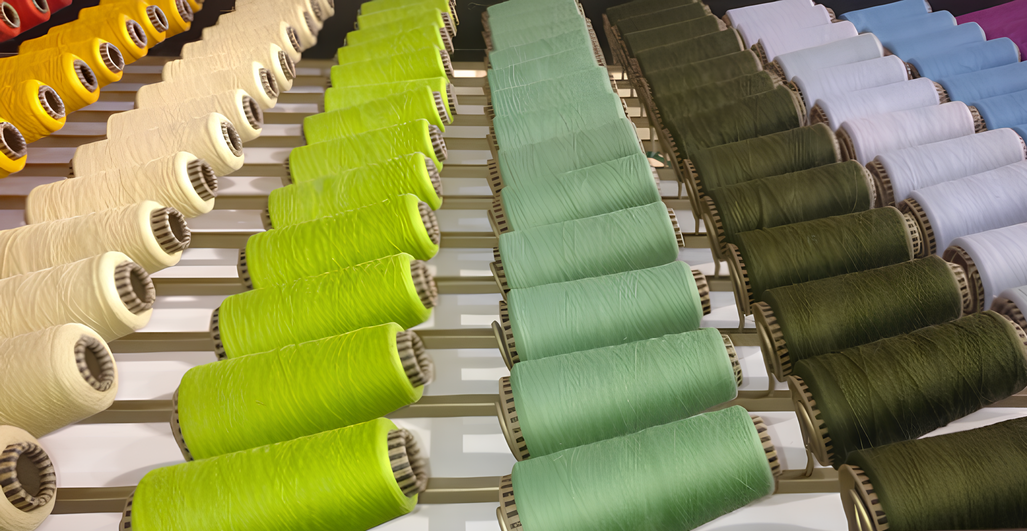
Hyper ReTex: AI at the service of Textile Recycling
Interview withInterview with Giovanni Marchi (President MagnoLab / CEO Marchi & Fildi S.p.a. and Filidea S.r.l.) and Luca Cinguino (Director Marchi & Fildi S.p.A. – Filidea S.r.l.)
Hyper ReTex is a cutting-edge project conceived – in collaboration with Japanese tech giant Konica Minolta – by Marchi & Fildi, a historic Italian textile Group based in Biella, specialized in yarn production.
Hyper ReTex is a machine that is able, thanks to the use of advanced Artificial Intelligence solutions and with the aid of hyperspectral cameras, to analyze quickly and at low cost yarns and their composition, discovering the textile composition of the examined materials.
We talk about this and more with Luca Cinguino (Director Marchi & Fildi S.p.A. – Filidea S.r.l.) and with Giovanni Marchi, who besides being CEO of Marchi & Fildi Group and of Filidea, is also the President of MagnoLab, a network of textile companies specialized in research and development activities for product innovation and for circular economy solutions.
Good morning, and thank you for your availability. How was the Hyper ReTex project born? How does it work in practice and what advantages does it offer for an important textile company like yours?
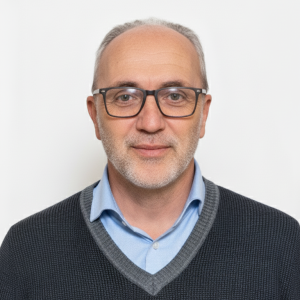 LUCA CINGUINO: The Hyper ReTex project was born within MagnoLab, a network of companies that was co-founded by Marchi & Fildi and that is focused on circular economy, recycling and recovery of waste materials.
LUCA CINGUINO: The Hyper ReTex project was born within MagnoLab, a network of companies that was co-founded by Marchi & Fildi and that is focused on circular economy, recycling and recovery of waste materials.
We have a partner company that deals with transforming textile waste into so-called “secondary raw material”, that is the material that is actually recovered and reused in production cycles. This material must be subdivided based on two criteria: by color and by composition.
If subdivision by color is relatively simple, subdivision by composition is a more complex process, which requires time and work if carried out by specialized personnel. And this is where Hyper ReTex intervenes, which is essentially an “intelligent lamp” that examines the fabrics that flow along a conveyor belt identifying their composition (through a complex calculation of data collected from different points of the analyzed product).
The strength of this AI solution does not lie so much in extreme precision (currently the instrument has a tolerance of 5%), as in the incredible speed of execution, with extremely reduced timescales: a few seconds to identify the composition of the material, which will become raw material and subsequently recycled yarns that we will then sell, compared to an activity that if performed by human personnel would require hours of work and often also the intervention of a laboratory.
Hyper ReTex has a software part that is 100% Made in Italy, which was developed by Konica Minolta in Italy, in the Rome laboratory, and has a hardware part of Asian production.
The product is already present at MagnoLab’s headquarters, in Magnonevolo (Biella), and anyone who wants to try it can contact us.
We must keep in mind that the new European regulations provide for the obligation of separate collection of textile products, which are already entering a specific supply chain that will determine important changes both in quantitative and qualitative terms. There are already important consortiums that deal specifically with the collection of these materials, such as Retex.Green, which is our partner and supplier, and it is clear that the theme of textile recycling will have a central and determining role in the coming years.
The Textile District of Biella continues to be at the forefront from the point of view of innovation, with its sights set on the front of ecology and solutions to make textile production more virtuous. The MagnoLab Consortium is at the center of this revolution in the approach to sector problems. How is the MagnoLab project going? What are the goals achieved three years after its foundation, and what are the objectives for the future?
GIOVANNI MARCHI: MagnoLab is a network of textile companies born in Biella in 2022 with the purpose of promoting innovation and circular economy projects.
How is it going? I would say very well. As co-founder and President of MagnoLab, I can say that the evolution of this network of companies is exceeding initial expectations.
In three years we have practically quadrupled the number of actors involved: we started with 6 companies and currently we are 21. We will soon be 24, given the imminent entry of three other companies. The network of associates, partners and sponsors expands every month, our market visibility is excellent and the requests we receive are many. Not always, to tell the truth, do we respond positively to those who contact us to develop projects or to join: the response depends on the sense and potential of the partnership that can be developed, as well as on the coherence or otherwise of the characteristics of the company making the request with respect to MagnoLab’s vision and mission. But we are open, naturally, to listening and carefully evaluating any proposal.
We are expanding our headquarters with important renovation work and we are also collaborating with other networks of companies in the sector, for example with Fili di Innovazione, which operates in the Como District.
LUCA CINGUINO: I would just add that MagnoLab is also a center for technical training. We collaborate from this point of view with schools, in particular with ITS TAM (Higher Technological Institute for Textile Clothing Fashion of Biella), and we provide textile companies with training courses to increase the skills of employees and collaborators and to introduce young people to the textile world. From this point of view too we are always available for any company that wants to contact us to deepen the discussion.
The last two years have not been brilliant for European industries in the textile sector. What are the most important problems to face and what are the aspects to focus on to return to growth?
GIOVANNI MARCHI: The situation is difficult for everyone. The textile crisis in Italy and Europe has been lasting for over two years now, because after a really brilliant 2021 and 2022, the end of 2023, 2024 and 2025 have seen a contraction in orders and revenues for the vast majority of sector operators.
The reasons for this crisis are multiple, but at least two aspects deserve to be highlighted: the slowdown of luxury on one hand, and on the other tariffs and the consequent alterations of import and export dynamics between Europe, the United States and Asia.
The world of luxury, which is strategic for many Italian textile producers, is in sharp slowdown, mainly due to price increases linked to cost increases. This dynamic has determined a contraction in sales of luxury products to that middle and upper-middle class segment of the population that represents the fundamental backbone of that market. Pay attention in fact: high fashion brands evidently do not prosper thanks to purchases by the super rich, but thanks to the fact that there are millions of “normal” people who, occasionally, indulge themselves, for themselves or to give gifts, and buy luxurious clothes and accessories, with an important economic effort but one that allows them to dream and satisfy desires. It is clear though that this type of buyers, if the price of a luxury product goes – for example – from two thousand euros to four thousand euros (but we have on the market figures and increases that are also much more significant…), are no longer able, or in any case no longer feel like making this type of purchases.
On the other hand, high fashion brands have a very different and over-determined cost structure compared to that of normal industrial producers, they have very high expenses for marketing and communication, and therefore cannot afford, also so as not to devalue the products, to decrease or freeze prices.
In this context, already quite complicated in itself, US tariffs have recently been inserted, which are determining two very serious consequences for European textile producers: on one hand the contraction of exports to the United States (due to tariffs and the weak dollar), on the other the fact that textile companies from Asian countries, partially losing commercial opportunities in the USA (due to tariffs), are significantly increasing exports to Europe, a continent seen today by some as a sort of “dumping ground” for excess textile production.
I am not speaking naturally of all Asian producers, some of whom offer quality products. I am describing however a general phenomenon that is heavily altering the market: the real invasion, in the last year, of Chinese and generally Asian textile products at very low prices, with very heavy consequences for European textile companies.
Having said that, I am always optimistic and see a positive evolution for the future, even if it is not clear when the situation will be able to improve. Certainly this crisis has been lasting for a long time, some Italian textile companies have closed and others unfortunately will close. The more solid companies, which will manage to stay afloat, at the end of the crisis will be able to grow by absorbing additional market shares.
One thing is certain: today in the textile field, but not only, the winning entrepreneurial choice has to do with the ability to diversify. It is now too dangerous to bet everything on one product or on a single market, in a context of uncertainty in which the arrival of certain tariffs, or a war or a specific geopolitical problem can sink a product or a market from one day to the next.
Marchi & Fildi and Filidea are two important realities of Made in Italy textiles and are in an expansion phase, both in Italy and outside Italian borders. What are the investments you are focusing on to further consolidate your market leadership?
GIOVANNI MARCHI: We are in a phase of settling and consolidating the investments made in recent years. We are bringing to full operation, for example, the investments of several million euros made recently in Turkey.
Today we are present with production facilities, in addition to Italy (in Biella), also in Brazil and Turkey, and we are working hard to strengthen synergies and opportunities between the different realities of our Group.


